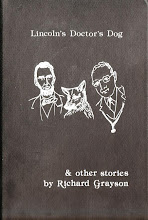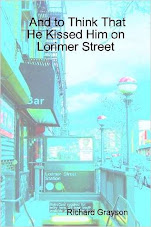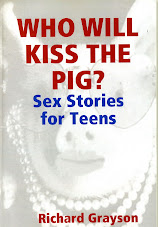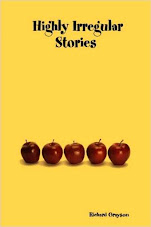
This was posted to Richard Grayson's MySpace blog on Tuesday, November 20, 2007:
Tuesday Night at Pierogi: Jonathan Baumbach and Others for The Brooklyn Rail
On Tuesday evening at 7 p.m. I walked the few blocks from home to the Williamsburg art gallery Pierogi for a reading sponsored by The Brooklyn Rail, the borough's great arts, politics and cultural monthly.
I was ill with bronchitis and had worked from 8 a.m. until 5:30 p.m. but I wanted to hear and see Jonathan Baumbach reading from his new novel You: Or the Invention of Memory.
I wasn't disappointed. Baumbach read chapter 12 from his galleys. It was a record of four "couples therapy" sessions for an estranged couple, Jay and Lois, with the marriage counselor Leo.
Baumbach's forte is literature about the day-to-day frustrations and pleasures and dramas of domestic life, and the excerpt had the author's right-as-reigned-in-fury dialogues between the couple, who at one point get beyond their contempt for each other to gang up on Leo.
I very much enjoyed chapter 12 of You and look forward to reading the novel when it's published any day now. Baumbach has written a dozen novels since the late 1960s, as well as four short story collections, including 2006's superb On the Way to My Father's Funeral.
I was grateful that Baumbach went first, because a paroxysm of coughing (and the attendant embarrassment) following his reading caused me to miss most of the other writers featured by The Brooklyn Rail: short story writer Diane Williams (It Was Like My Trying to Have a Tender-Hearted Nature), novelist Cees Nooteboom (Lost Paradise) and poet Jerome Rothenberg (Triptych). I hope I can catch them another time.
Full disclosure: I first met Jonathan Baumbach when I took him for a short story writing class at Brooklyn College in the fall of 1971, when he introduced me to such writers as Donald Barthelme, Grace Paley, Walter Abish and John Hawkes.
From 1974 to 1976, I was a student in Brooklyn's nascent MFA program in creative writing, and Baumbach was the director of the fiction program whom I had as my teacher in both workshops and tutorials. I also worked for him and another MFA professor, the novelist Peter Spielberg, for several years at the then-new Fiction Collective, of which they were the founding co-directors.
But until Tuesday's reading, I had not seen or spoken to Jonathan Baumbach in thirty years. However, I've continued to enjoy his writing. Long careers in fiction writing in America are rare and confined mostly to household names like Mailer, Updike and Roth. Baumbach's longevity is due to many of his strengths as a writer, and I am pretty sure that I would admire him even if I had never met him.





































